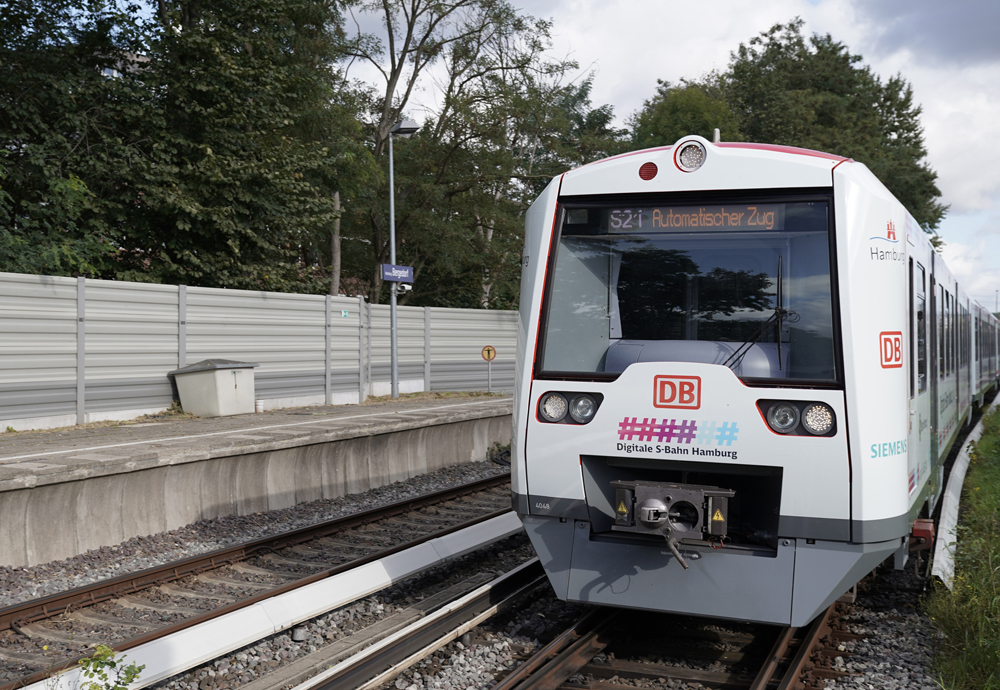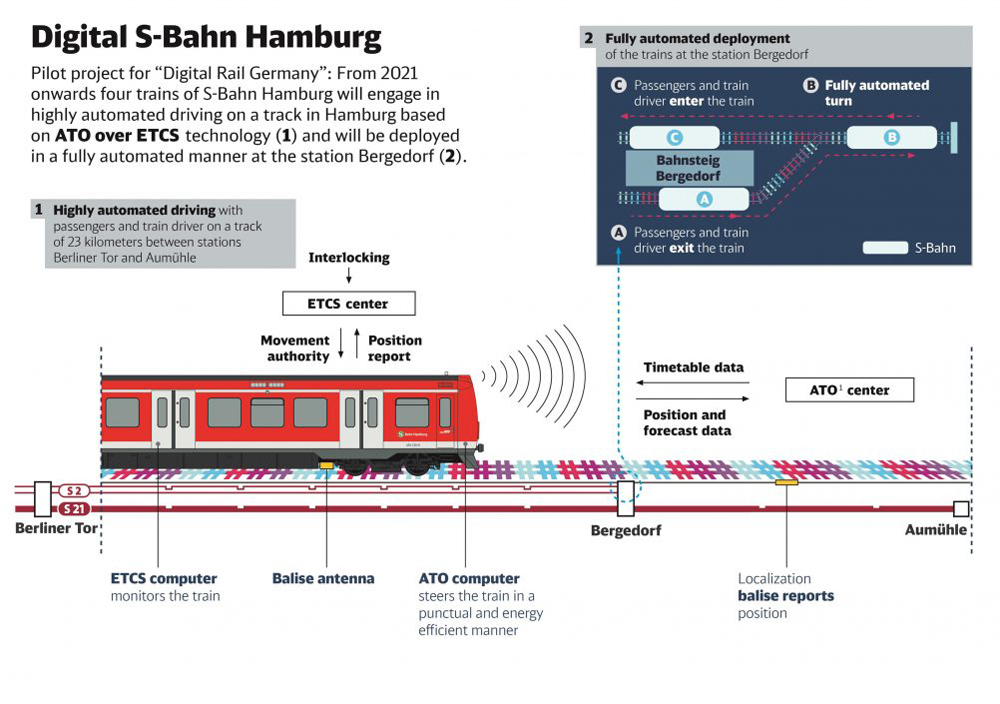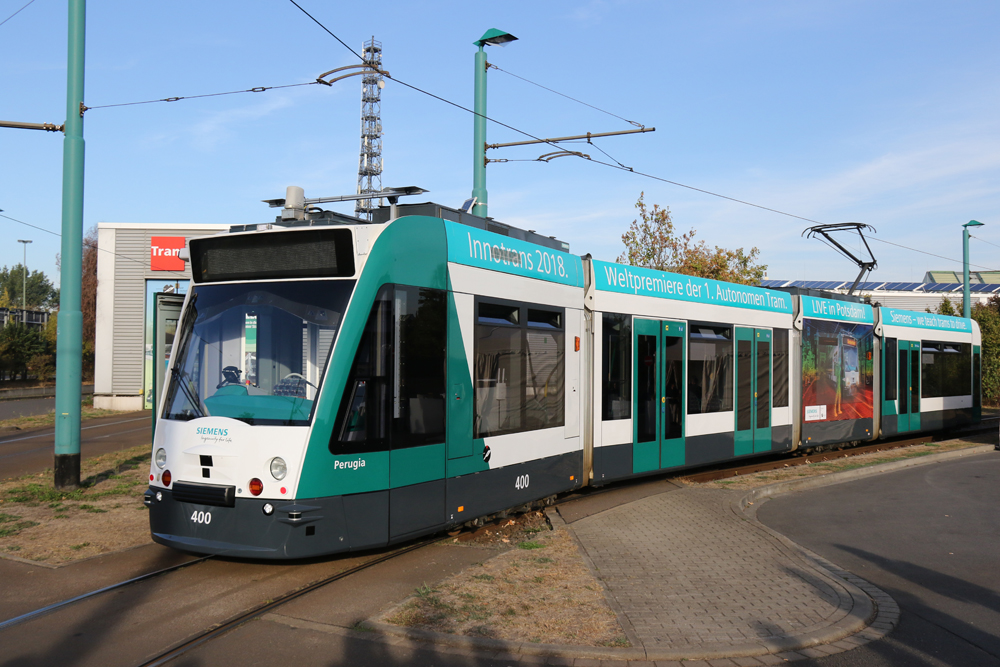
HAMBURG, Germany — Rail equipment firm Siemens has launched two types of driverless train operations in Germany, introducing a commuter train in the northern port city of Hamburg and a fully autonomous streetcar in Potsdam, just west of Berlin. The company is working toward making both technologies commercially available within a few years, as is major European rival Alstom.
While fully automated subway trains are fairly common in both Europe and Asia, autonomous self-driving mainline trains are very rare. Freight trains operated by mining company Rio Tinto in northwestern Australia have operated long distances without onboard crews since 2018, but this is in a very remote area with few people, settlements, or roads.
The Siemens test train in Hamburg is one of the city’s ‘S-Bahn’ commuter rail EMUs and was presented to delegates at a major technology conference in the city on Oct. 11. The train has been equipped with a unique combination of three technologies, which between them permit driverless operation. Two existing rail technologies — Automatic Train Operation (ATO) and the European radio-based positive train control system ETCS (European Train Control System) — have been married with new 5G wireless telecom networks to permit fully automated operation. It will initially be used only for empty trains running to and from storage tracks.
The combination of ATO and ETCS is not entirely new. Siemens pioneered this in London in early 2018 when the central core of the cross-city Thameslink route started using this technology for passenger-carrying trains. However, in London, the train engineer remains onboard and supervises the system, although in normal operations the individual has nothing to do as the train crosses the city center.

In Hamburg this has been taken a step further for empty trains. The engineer leaves the train when it arrives at the Bergedorf terminus station, while the train moves to storage tracks and at the correct time moves back to another platform to prepare for a departure. Initially, for the Hamburg trial, only four trains have been equipped. These, like the Thameslink trains in London, also run for around 15 miles between Berliner Tor and Aumuhle stations using the ATO+ETCS system so the engineer ordinarily needs do nothing, although with passengers onboard he or she is there to intervene if needed.
The Hamburg S-Bahn is an enclosed rail environment with lineside fences and high platforms, using third-rail power like New York-area commuter line Metro North. The trial program has cost around $70 million, funded by rail operator Deutsche Bahn (DB) , Siemens and the City of Hamburg. Siemens says the technology will enable DB to operate up to 30% more trains without adding more track, as well as improving energy efficiency, as over time the trains will learn to optimize their own operation.
Alstom is supplying new trains to the Hamburg S-Bahn system, having inherited the contract when it bought Bombardier earlier this year. The latest order is for 64 more trains equipped with the ATO+ETCS system, although these will utilize Alstom technology rather than that of Siemens. Alstom has spoken publicly about its plans for automated trains and expects prototype mainline trains to be tested as early as 2023 on open rail lines in Europe. Such lines, often without fences and with grade crossings, pose huge challenges to engineers developing such automated systems, as a train’s long braking distance means track obstacles must be reliably identified far ahead and in time to react.
Autonomous streetcars moving forward

Siemens and Potsdam light rail operator ViP, located just west of Berlin, presented the world’s first autonomous self-driving streetcar at the time of the Innotrans trade fair in 2018. Then, the vehicle — equipped with multiple sensors and cameras plus an onboard computer — was supervised by a human driver. The technology has moved on and Siemens along with ViP have recently shown the autonomous streetcar is now able to operate within the streetcar shop area without a driver or even someone ‘supervising’ it.
The trial system branded AStriD (Autonome Strassenbahn im Depot, or Autonomous tram in depot) has been developed by several research organisations in Germany, with funding from the German Federal transport ministry as well as Siemens. More research is planned, and Siemens say it expects to be ready to sell the system to operators in Germany and elsewhere by 2026. Given shortages of trained drivers, autonomous operation within shop areas may be more attractive to many operators than it at first seems, as it could mean that trained drivers are only used for revenue services rather than moving empty vehicles.












Airline computers kept the crew from operating their plane, which resulted in a horrific crash killing all and grounding the whole fleet of these Boeing planes.
For grade separated passenger rail, driverless trains really are a no brainer (pun unintended), and hardly new technology. The only crash that DLR in London has had in 3 decades of driverless operations was when a test train was being manually driven.
Even with grade crossings, if you don’t trust the crossing to properly operate, that’s not really going to be solved with a driver…
The MBTA “tested” a driverless Red Line subway train almost 6 years ago!
https://www.boston.com/news/local-news/2016/05/06/mbta-releases-footage-runaway-red-line-train/
We could become elevator operators?
Actually US lawyers are looking longingly at driverless trains. Unattended moving equipment!!!!
US trains may have no on-board employees but there will be many more lawyers to deal with the claims.
Driverless trains will allow railways to be more economically and technologically competitive with driverless trucks (aka lorries in Europe) and automobiles.
My paediatrician’s prediction in the 1960s is coming true. Technology will replace human operators on trains. Railways are the natural beneficiaries of the driverless technology as trains already require no manual steering.
Every locomotive engineer/transit motorperson, conductor, train dispatcher, and signal maintainer working today has a crosshairs trained (no pun intended) on their backs. And every retiree receiving a pension from the Railroad Retirement System ought to be worried sick. The number of active employees paying in to the RRSystem, after all the layoffs at the Class 1s and Amtrak due to the Great Recession, PSR, and Amtrak’s October 2020 massacre has got to be smaller than the the numbers taking out.
The ultimate goal of all industries is to go completely automated, with zero employees needed…